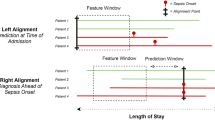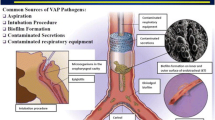Abstract
Cardiorespiratory instability (CRI) in monitored step-down unit (SDU) patients has a variety of etiologies, and likely manifests in patterns of vital signs (VS) changes. We explored use of clustering techniques to identify patterns in the initial CRI epoch (CRI1; first exceedances of VS beyond stability thresholds after SDU admission) of unstable patients, and inter-cluster differences in admission characteristics and outcomes. Continuous noninvasive monitoring of heart rate (HR), respiratory rate (RR), and pulse oximetry (SpO2) were sampled at 1/20 Hz. We identified CRI1 in 165 patients, employed hierarchical and k-means clustering, tested several clustering solutions, used 10-fold cross validation to establish the best solution and assessed inter-cluster differences in admission characteristics and outcomes. Three clusters (C) were derived: C1) normal/high HR and RR, normal SpO2 (n = 30); C2) normal HR and RR, low SpO2 (n = 103); and C3) low/normal HR, low RR and normal SpO2 (n = 32). Clusters were significantly different based on age (p < 0.001; older patients in C2), number of comorbidities (p = 0.008; more C2 patients had ≥ 2) and hospital length of stay (p = 0.006; C1 patients stayed longer). There were no between-cluster differences in SDU length of stay, or mortality. Three different clusters of VS presentations for CRI1 were identified. Clusters varied on age, number of comorbidities and hospital length of stay. Future study is needed to determine if there are common physiologic underpinnings of VS clusters which might inform clinical decision-making when CRI first manifests.


Similar content being viewed by others
References
Hravnak M, Edwards L, Clontz A, Valenta C, DeVita MA, Pinsky MR. Defining the incidence of cardiorespiratory instability in patients in step-down units using an electronic integrated monitoring system. Arch Intern Med. 2008;168(12):1300–8.
Buist MD, Moore GE, Bernard SA, Waxman BP, Anderson JN, Nguyen TV. Effects of a medical emergency team on reduction of incidence of and mortality from unexpected cardiac arrests in hospital: preliminary study. Bmj. 2002;324(7334):387–90.
Hillman K, Chen J, Cretikos M, Bellomo R, Brown D, Doig G, Finfer S, Flabouris A, Investigators MS. Introduction of the medical emergency team (MET) system: a cluster-randomised controlled trial. The Lancet. 2005;365(9477):2091–7.
Bellomo R, Goldsmith D, Uchino S, Buckmaster J, Hart GK, Opdam H, Silvester W, Doolan L, Gutteridge G. A prospective before-and-after trial of a medical emergency team. Med J Aust. 2003;179(6):283–8.
Bristow PJ, Hillman KM, Chey T, Daffurn K, Jacques TC, Norman SL, Bishop GF, Simmons EG. Rates of in-hospital arrests, deaths and intensive care admissions: the effect of a medical emergency team. Med J Aust. 2000;173(5):236–40.
DeVita M, Braithwaite R, Mahidhara R, Stuart S, Foraida M, Simmons R. Use of medical emergency team responses to reduce hospital cardiopulmonary arrests. Quality Safety Health Care 2004;13(4):251–254.
Downey AW, Quach JL, Haase M, Haase-Fielitz A, Jones D, Bellomo R. Characteristics and outcomes of patients receiving a medical emergency team review for acute change in conscious state or arrhythmias*. Crit Care Med. 2008;36(2):477–81.
Jones D, Duke G, Green J, Briedis J, Bellomo R, Casamento A, Kattula A, Way M. Medical emergency team syndromes and an approach to their management. Critical care. 2006;10(1):R30.
Jones D, Bates S, Warrillow S, Goldsmith D, Kattula A, Way M, Gutteridge G, Buckmaster J, Bellomo R. Effect of an education programme on the utilization of a medical emergency team in a teaching hospital. Intern Med J. 2006;36(4):231–6.
Alpaydin E. Introduction to machine learning. 2nd ed. Boston: MIT press; 2014
Jang E-H, Park B-J, Kim S-H, Sohn J-H. Emotion recognition by machine learning algorithms using psychophysiological signals. Int J Eng Ind. 2012;3 (1).
AlZoubi O, Mello SK, Calvo R. Detecting naturalistic expressions of nonbasic affect using physiological signals. IEEE Trans Affect Comput. 2012;3 (3):298–310.
Martinez HP, Bengio Y, Yannakakis GN. Learning deep physiological models of affect. IEEE Comput Intell Mag. 2013;8 (2):20–33.
Jain AK, Murty MN, Flynn PJ. Data clustering: a review. ACM computing surv (CSUR). 1999;31 (3):264–323.
Tibshirani R, Walther G, Hastie T. Estimating the number of clusters in a data set via the gap statistic. J R Stat Soc B. 2001;63(2):411–23.
Eisen MB, Spellman PT, Brown PO, Botstein D. Cluster analysis and display of genome-wide expression patterns. Proceedings of the National Academy of Sciences. 1998;95(25):14863–8.
Agrawal R, Srikant R Mining sequential patterns. In: Data Engineering, 1995. Proceedings of the Eleventh International Conference on, 1995. IEEE, pp 3–14.
Larrañaga P, Calvo B, Santana R, Bielza C, Galdiano J, Inza I, Lozano JA, Armañanzas R, Santafé G, Pérez A. Machine learning in bioinformatics. Brief Bioinform. 2006;7(1):86–112.
Sarstedt M, Mooi E. A concise guide to market research: the process, data, and methods using IBM SPSS statistics. Berlin: Springer; 2014.
Ward JH Jr. Hierarchical grouping to optimize an objective function. Journal of the American statistical association. 1963;58(301):236–44.
Jain AK, Dubes RC. Algorithms for clustering data. New Jersey: Prentice-Hall, Inc; 1988.
Murtagh F. A survey of recent advances in hierarchical clustering algorithms. The Computer Journal. 1983;26(4):354–9.
Steinley D. K-means clustering: a half-century synthesis. Br J Math Stat Psychol. 2006;59(1):1–34.
Jain AK. Data clustering: 50 years beyond K-means. Pattern recognition letters. 2010;31(8):651–66.
McLachlan G, Do K, Ambroise C. Analyzing microarray gene expression data. Vol. 422. New Jersey: John Wiley & Sons; 2005.
Deyo RA, Cherkin DC, Ciol MA. Adapting a clinical comorbidity index for use with ICD-9-CM administrative databases. J Clin Epidemiol. 1992;45(6):613–9.
Brown H, Terrence J, Vasquez P, Bates DW, Zimlichman E. Continuous monitoring in an inpatient medical-surgical unit: a controlled clinical trial. Am J Med. 2014;127(3):226–32.
Hravnak M, Chen L, Dubrawski A, Clermont G, Bose E, Fiterau M, Wang D, Guillame-Bert M, Pinsky M. Supervised Machine Learning Can Classify Artifact In Multi-Signal Vital Sign Monitoring Data Erom Step-Down Unit (SDU) Patients. In: Intensive Care Medicine, 2014. p S28.
Haldar P, Pavord ID, Shaw DE, Berry MA, Thomas M, Brightling CE, Wardlaw AJ, Green RH. Cluster analysis and clinical asthma phenotypes. Am J Respir Crit Care Med. 2008;178(3):218–24.
Cellucci T, Tyrrell PN, Twilt M, Sheikh S, Benseler SM. Distinct phenotype clusters in childhood inflammatory brain diseases: implications for diagnostic evaluation. Arthritis &. Rheumatology. 2014;66(3):750–6.
Devaney M, Ram A Efficient feature selection in conceptual clustering. In: ICML, 1997. pp 92–97.
Talavera L Feature selection as a preprocessing step for hierarchical clustering. In: International Conference of Machine Learning Proceedings (ICML), 1999. pp 389–397.
Hastie T, Tibshirani R, Friedman J. Unsupervised learning. In: The Elements of Statistical Learning. Second, editor. Edition. New York: Springer; 2009. pp. 485–585.
Arai K, Barakbah AR (2007) Hierarchical K-means: an algorithm for centroids initialization for K-means. Reports of the Faculty of Science and Engineering 36 (1):25–31.
Mooi E, Sarstedt M. Cluster analysis. In: A Concise Guide to Market Research: The Process, Data, and Methods Using IBM SPSS Statistics. Berlin: Springer-Verlag; 2011. pp. 273–98.
Milligan GW, Cooper MC. An examination of procedures for determining the number of clusters in a data set. Psychometrika. 1985;50(2):159–79.
Hawkins MA, Schaefer JT, Gunstad J, Dolansky MA, Redle JD, Josephson R, Moore SM, Hughes JW. What is your patient’s cognitive profile? Three distinct subgroups of cognitive function in persons with heart failure. Appl Nurs Res. 2015;28(2):186–91.
Stuetzle W, Nugent R. A generalized single linkage method for estimating the cluster tree of a density. Journal of Computational Graphical Statistics. 2012;19(2):397–418.
Clarke B, Fokoue E, Zhang HH. Principles and theory for data mining and machine learning. New York: Springer Science & Business Media; 2009.
Wagstaff K, Cardie C, Rogers S, Schrödl S Constrained k-means clustering with background knowledge. In: International Conference on Machine Learning (ICML), 2001. pp 577–584.
Schaffer C A conservation law for generalization performance. In: Proceedings of the 11th international conference on machine learning, 1994. pp 259–265.
Duda RO, Hart PE, Stork DG. Pattern classification. 2nd ed. New York: Wiley; 2012.
Clermont G, Sileanu F, Pinsky M, Ogundele O. Physiologic Variable Analysis Between Hemodynamic Stable And Unstable Patients. Am J Respir Crit Care Med. 2012;185:A4630.
Clermont G, Sileanu F, Pinsky M, Ogundele O. Use Of Derived Physiologic Variables To Predict Individual Patients’ Probability Of Hemodynamic Instability. Am J Respir Crit Care Med. 2013;187:A5067.
Smith GB, Prytherch DR, Schmidt PE, Featherstone PI, Higgins B. A review, and performance evaluation, of single-parameter “track and trigger” systems. Resuscitation. 2008;79(1):11–21.
Hravnak M, DeVita MA, Clontz A, Edwards L, Valenta C, Pinsky MR. Cardiorespiratory instability before and after implementing an integrated monitoring system. Crit Care Med. 2011;39(1):65.
Honaker J, King G. What to do about missing values in time-series cross-section data. American Journal of Political Science. 2010;54(2):561–81.
Honaker J, King G, Blackwell M. Amelia II: A program for missing data. Journal of Statistical Software. 2011;45(7):1–47.
Acknowledgements
This study was funded with grant support from the United States National Institutes of Health, National Institute of Nursing Research RO1 NR13912 and the National Science Foundation NSF 1320347.
Funding
This study was funded with grant support from the United States National Institutes of Health, National Institute of Nursing Research RO1 NR13912 and the National Science Foundation NSF 1,320,347. The funding bodies approved the study design as submitted in the grant application proposal, but had no role in the data collection, analyses, or interpretation, manuscript preparation, or decision to submit the manuscript for publication.
Author information
Authors and Affiliations
Corresponding author
Ethics declarations
Ethical approval
The study was approved and has current active approval from the University of Pittsburgh Institutional Review Board (PRO12070002). All procedures performed in this study involving human participants were in accordance with the ethical standards of the institutional and/or national research committee and with the 1964 Helsinki declaration and its later amendments or comparable ethical standards. For this type of study formal consent is not required, and was approved with consent waiver.
Conflict of interest
The authors have no commercial conflicts of interest to report.
Rights and permissions
About this article
Cite this article
Bose, E.L., Clermont, G., Chen, L. et al. Cardiorespiratory instability in monitored step-down unit patients: using cluster analysis to identify patterns of change. J Clin Monit Comput 32, 117–126 (2018). https://doi.org/10.1007/s10877-017-0001-7
Received:
Accepted:
Published:
Issue Date:
DOI: https://doi.org/10.1007/s10877-017-0001-7




